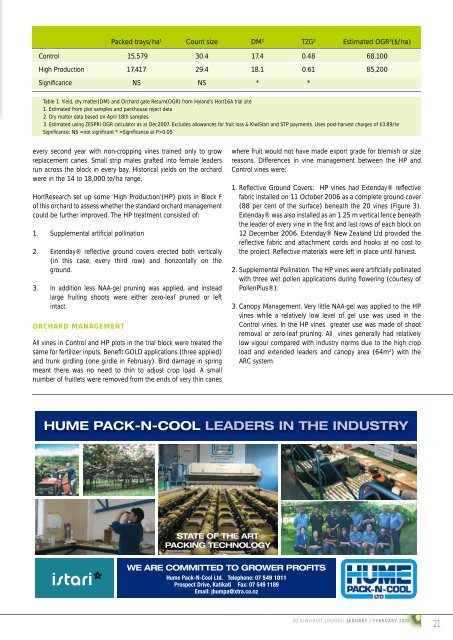Thirsty vines Summer girdling Compost teas Organic marketing The ...
Thirsty vines Summer girdling Compost teas Organic marketing The ...
Thirsty vines Summer girdling Compost teas Organic marketing The ...
You also want an ePaper? Increase the reach of your titles
YUMPU automatically turns print PDFs into web optimized ePapers that Google loves.
every second year with non-cropping <strong>vines</strong> trained only to grow<br />
replacement canes. Small strip males grafted into female leaders<br />
run across the block in every bay. Historical yields on the orchard<br />
were in the 14 to 18,000 te/ha range.<br />
HortResearch set up some ‘High Production’(HP) plots in Block F<br />
of this orchard to assess whether the standard orchard management<br />
could be further improved. <strong>The</strong> HP treatment consisted of:<br />
1. Supplemental artifi cial pollination<br />
2. Extenday® refl ective ground covers erected both vertically<br />
(in this case, every third row) and horizontally on the<br />
ground.<br />
3. In addition less NAA-gel pruning was applied, and instead<br />
large fruiting shoots were either zero-leaf pruned or left<br />
intact.<br />
ORCHARD MANAGEMENT<br />
Packed trays/ha 1 Count size DM 2 TZG 2 Estimated OGR 3 ($/ha)<br />
Control 15,579 30.4 17.4 0.48 68,100<br />
High Production 17,417 29.4 18.1 0.61 85,200<br />
Signifi cance NS NS * *<br />
Table 1. Yield, dry matter(DM) and Orchard gate Return(OGR) from Hyland’s Hort16A trial site<br />
1. Estimated from plot samples and packhouse reject data<br />
2. Dry matter data based on April 18th samples.<br />
3. Estimated using ZESPRI OGR calculator as at Dec2007. Excludes allowances for fruit loss & KiwiStart and STP payments. Uses post-harvest charges of $3.89/te<br />
Signifi cance: NS =not signifi cant * =Signifi cance at P>0.05<br />
All <strong>vines</strong> in Control and HP plots in the trial block were treated the<br />
same for fertilizer inputs, Benefi t GOLD applications (three applied)<br />
and trunk <strong>girdling</strong> (one girdle in February). Bird damage in spring<br />
meant there was no need to thin to adjust crop load. A small<br />
number of fruitlets were removed from the ends of very thin canes<br />
HUME PACK-N-COOL LEADERS IN THE INDUSTRY<br />
STATE OF THE ART<br />
PACKING TECHNOLOGY<br />
WE ARE COMMITTED TO GROWER PROFITS<br />
Hume Pack-N-Cool Ltd. Telephone: 07 549 1011<br />
Prospect Drive, Katikati Fax: 07 549 1189<br />
Email: jhumpa@xtra.co.nz<br />
where fruit would not have made export grade for blemish or size<br />
reasons. Differences in vine management between the HP and<br />
Control <strong>vines</strong> were:<br />
1. Refl ective Ground Covers: HP <strong>vines</strong> had Extenday® refl ective<br />
fabric installed on 11 October 2006 as a complete ground cover<br />
(88 per cent of the surface) beneath the 20 <strong>vines</strong> (Figure 3).<br />
Extenday® was also installed as an 1.25 m vertical fence beneath<br />
the leader of every vine in the fi rst and last rows of each block on<br />
12 December 2006. Extenday® New Zealand Ltd provided the<br />
refl ective fabric and attachment cords and hooks at no cost to<br />
the project. Refl ective materials were left in place until harvest.<br />
2. Supplemental Pollination. <strong>The</strong> HP <strong>vines</strong> were artifi cially pollinated<br />
with three wet pollen applications during fl owering (courtesy of<br />
PollenPlus®).<br />
3. Canopy Management. Very little NAA-gel was applied to the HP<br />
<strong>vines</strong> while a relatively low level of gel use was used in the<br />
Control <strong>vines</strong>. In the HP <strong>vines</strong> greater use was made of shoot<br />
removal or zero-leaf pruning. All <strong>vines</strong> generally had relatively<br />
low vigour compared with industry norms due to the high crop<br />
load and extended leaders and canopy area (64m 2 ) with the<br />
ARC system.<br />
NZ KIWIFRUIT JOURNAL JANUARY / FEBRUARY 2008<br />
21


